A VIKOR-Based Linguistic Multi-Attribute Group Decision-Making Model in a Quantum Decision Scenario
Abstract
:1. Introduction
1.1. Literature Review
1.2. Motivations and Innovations
- Although LDAs with sample capacity can well-express group linguistic evaluation, the distance measure of LDAs in previous studies is not applicable to LDAs with sample capacity. Therefore, it is necessary to develop a new distance measure to compare LDAs with sample capacity.
- The problem of attributes conflict can be handled by VIKOR method; we try to extend VIKOR method to the context of LDAs. When considering the interaction of decision-makers in a group, how to reflect the group interaction relationship based on this method?
- In the process of dealing with MAGDM problems, it is necessary to consider the asymmetric influence among decision-makers when using QPT. Therefore, it is significant to explore the asymmetric interference effect in the quantum decision framework.
- A new distances measure is developed for LDAs, which can preserve the integrity of linguistic information.
- We propose an LDAs–VIKOR method to obtain a set of compromise results instead of a single result. It provides a new decision-making mechanism for decision-makers when circumstances are uncertain.
- We combine the QPT with the LDAs–VIKOR method to reflect the interaction among decision-makers. The asymmetric interference is proposed to describe the degree of interaction of a group in a more detailed and realistic manner.
2. Preliminaries
2.1. LDAs with Sample Capacity for Group Evaluations
2.2. Quantum Probability Theory (QPT) and the Interference Term
3. Asymmetric Interference Effects between Decision-Makers
- ,
- .
4. An LDAs–VIKOR MAGDM Model Considering Asymmetric Interference in Quantum Decision Framework
4.1. Problem Description
- Establish a decision group including subgroups , and determine alternatives and attributes;
- Collect the linguistic evaluation information of each subgroup and form the LDAs matrix of subgroup ;
- Determine the weights of attributes and subgroups;
- Determine the positive ideal points and negative ideal points in each column of each subgroup’s LDAs matrix;
- Calculate the LDAs overall utility and LDAs individual regret of according to positive ideal points and negative ideal points;
- Integrate all subgroups’ LDAs overall utility and LDAs individual regret in the quantum decision framework considering the asymmetric interference effects, respectively;
- Obtain the group LDAs overall utility and LDAs individual regret;
- Calculate the general LDAs–VIKOR index of each alternative;
- Rank the alternative according to the ranking rules of LDAs–VIKOR.
4.2. The Quantum LDAs–VIKOR Decision Model for MAGDM
4.2.1. The LDAs–VIKOR Method
- If both Con1 and Con2 are satisfied, then is the best solution.
- If Con1 is not satisfied, then is a set of compromise solutions whenever the maximum value of satisfy the formula: .
- If Con2 is not satisfied, then the compromise solutions are alternatives and .
- (1)
- When, it is the Hamming-Hausdorff distance;
- (2)
- When, it is the Euclidean-Hausdorff distance.
- (1)
- Non-negativity:;
- (2)
- Reflexivity:;
- (3)
- Reciprocity:;
- (4)
- Transitivity: if,, then.
4.2.2. Form Opinion of Subgroup by LDAs–VIKOR Method
- (1)
- The LDAs overall utility over alternative of subgroup could be calculated as follows:
- (2)
- The LDAs individual regret over alternative of subgroup could be calculated as follows:where is the weight of attribute of subgroup . and represent the distance to ‘‘ideal’’ solution of each alternative. It can be computed by Equation (15).
4.2.3. Aggregate Opinions of All Subgroups in Quantum Decision Framework
- Asymmetric opinion interference among any two subgroups in a quantum decision framework.
- When , and , there is no interference among subgroups. Each subgroup is considered completely independent to others. Then the proposed model degenerates into the classical Bayesian network.
- When and , there exists positive interference among two subgroups. If and , their opinions are completely affected positively. The subgroups are regarded as complete positive-related.
- When , there exists negative interference among two subgroups, if , their opinions are completely affected negatively. The subgroups are regarded as complete negative-related.
- 2.
- Determine the value of the interference terms by belief entropy.
5. Case Study
5.1. The Evaluation Steps
5.2. Sensitivity Analysis
- When , the rank list is , the alternative is the best; when , the rank list is still , but the compromise solutions are and , indicating that and are the best candidates;
- When , the rank list is still , and the compromise solutions are and . It can be found from the above analysis that in most cases, the rank list of alternatives is , and the compromise solutions are and .
5.3. Discussion
- Yu et al. [14] proposed LDAs for group evaluation first, but they ignored the sample capacity information; the proposed LDAs distance measure using max or min operator would result in loss of information. Our paper proposes a new LDAs distance measure based on [57] that can effectively avoid this problem.
- In the process of information fusion, Yu et al. [14] and Huang et al. [58] assumed that decision-makers are independent. The proposed model explores the dependence of subgroups (corresponding to the concept of decision-makers) in the quantum decision-making framework to reflect the opinion interference and superposition effects.
- Wu et al. [57] also integrated the opinions of subgroups in the quantum decision framework, but they assumed that the interference effects are symmetric, and the value of interference term is unsolved. In this paper, the interference effects are divided into symmetric interference and asymmetric interference ones. The belief entropy method is used to determine the value of the interference terms to obtain the alternatives’ ranking results. In addition, the LDAs–VIKOR method combined with quantum probability may provide compromise solutions for alternatives with conflicting attributes.
6. Conclusions
- LADs with sample capacity information are used to deal with the linguistic terms of group linguistic evaluations statistically, which is more reasonable in a MAGDM problem. Meanwhile, we proposed a new distance measurement method that can effectively avoid information loss and make the results more accurate.
- Quantum probability theory can well model interference effects and superposition effects of decision-makers in MAGDM. When modeling interference effects in the quantum decision-making framework, an LDAs–VIKOR method is used to obtain a compromise solution, which makes the results more realistic.
- The main novelty of this paper is to divide interference effects into symmetric and asymmetric ones when solving MAGDM problems. The existence of asymmetric interference is also proved by formula derivation theoretically. In addition, we adopt the belief entropy method to quantify the interference terms.
- The weights of attributes and subgroups in this paper are set subjectively. Different weight-setting methods may lead to different decision results. How to determine a more objective weight requires further research.
- As the number of decision-makers and alternatives increases, the quantum decision model considering asymmetric interference effects is more complex than the general quantum decision model, and the number of interference terms increases rapidly. It may cause some difficulties in practice.
- We start by deriving the interference term for two decision-makers for simplicity, and generalize interference effects for decision-makers by deriving one of the two decision-makers. However, this simplification may lead to distortion of information. After all, people’s psychological behavior is very complex. At present, there are no experimental results to prove that the interaction of more than three people will not have new effects.
Author Contributions
Funding
Institutional Review Board Statement
Informed Consent Statement
Data Availability Statement
Conflicts of Interest
References
- Liang, W.; Goh, M.; Wang, Y.-M. Multi-attribute group decision making method based on prospect theory under hesitant probabilistic fuzzy environment. Comput. Ind. Eng. 2020, 149, 106804. [Google Scholar] [CrossRef]
- Porro, O.; Agell, N.; Sánchez, M.; Ruiz, F.J. A multi-attribute group decision model based on unbalanced and multi-granular linguistic information: An application to assess entrepreneurial competencies in secondary schools. Appl. Soft Comput. 2021, 111, 107662. [Google Scholar] [CrossRef]
- Rao, C.; Gao, M.; Wen, J.; Goh, M. Multi-attribute group decision making method with dual comprehensive clouds under information environment of dual uncertain Z-numbers. Inf. Sci. 2022, 602, 106–127. [Google Scholar] [CrossRef]
- Liang, W.; Wang, Y. Interval-Valued Hesitant Fuzzy Stochastic Decision-Making Method Based on Regret Theory. Int. J. Fuzzy Syst. 2020, 22, 1091–1103. [Google Scholar] [CrossRef]
- Guha, D.; Dutta, B. Health-System Evaluation: A Multi-attribute Decision Making Approach. Adv. Intell. Syst. Comput. 2015, 340, 359–367. [Google Scholar]
- Gao, H.; Ran, L.; Wei, G.; Wei, C.; Wu, J. VIKOR Method for MAGDM Based on Q-Rung Interval-Valued Orthopair Fuzzy Information and Its Application to Supplier Selection of Medical Consumption Products. Int. J. Environ. Res. Public Health 2020, 17, 525. [Google Scholar] [CrossRef] [Green Version]
- Qin, J.; Liu, X.; Pedrycz, W. An extended TODIM multi-criteria group decision making method for green supplier selection in interval type-2 fuzzy environment. Eur. J. Oper. Res. 2017, 258, 626–638. [Google Scholar] [CrossRef]
- Xu, Z. A method based on linguistic aggregation operators for group decision making with linguistic preference relations. Inf. Sci. 2004, 166, 19–30. [Google Scholar] [CrossRef]
- Pang, Q.; Wang, H.; Xu, Z. Probabilistic linguistic term sets in multi-attribute group decision making. Inf. Sci. 2016, 369, 128–143. [Google Scholar] [CrossRef]
- Herrera, F.; Martinez, L. A 2-tuple fuzzy linguistic representation model for computing with words. IEEE Trans. Fuzzy Syst. 2000, 8, 746–752. [Google Scholar]
- Rodriguez, R.M.; Martinez, L.; Herrera, F. Hesitant Fuzzy Linguistic Term Sets for Decision Making. IEEE Trans. Fuzzy Syst. 2012, 20, 109–119. [Google Scholar] [CrossRef]
- Zhang, G.; Dong, Y.; Xu, Y. Consistency and consensus measures for linguistic preference relations based on distribution assessments. Inf. Fusion 2014, 17, 46–55. [Google Scholar] [CrossRef]
- Liang, H.; Chen, X.; Li, C.-C.; Zhang, H. Linguistic stochastic dominance to support consensus reaching in group decision making with linguistic distribution assessments. Inf. Fusion 2021, 76, 107–121. [Google Scholar] [CrossRef]
- Yu, S.-m.; Wang, J.; Wang, J.-Q.; Li, L. A multi-criteria decision-making model for hotel selection with linguistic distribution assessments. Appl. Soft Comput. 2018, 67, 741–755. [Google Scholar] [CrossRef]
- Wu, Q.; Liu, X.; Qin, J.; Wang, W.; Zhou, L. A linguistic distribution behavioral multi-criteria group decision making model integrating extended generalized TODIM and quantum decision theory. Appl. Soft Comput. 2021, 98, 106757. [Google Scholar] [CrossRef]
- Hafezalkotob, A.; Hafezalkotob, A.; Liao, H.; Herrera, F. An overview of Multimoora for multi-criteria decision-making: Theory, developments, applications, and challenges. Inf. Fusion 2019, 51, 145–177. [Google Scholar] [CrossRef]
- Wang, P.; Zhu, Z.; Wang, Y. A novel hybrid MCDM model combining the SAW, TOPSIS and GRA methods based on experimental design. Inf. Sci. 2016, 345, 27–45. [Google Scholar] [CrossRef]
- Stojić, G.; Stević, Ž.; Antuchevičienė, J.; Pamučar, D.; Vasiljević, M. A Novel Rough WASPAS Approach for Supplier Selection in a Company Manufacturing PVC Carpentry Products. Information 2018, 9, 121. [Google Scholar] [CrossRef] [Green Version]
- Zahid, K.; Akram, M.; Kahraman, C. A new ELECTRE-based method for group decision-making with complex spherical fuzzy information. Knowl. -Based Syst. 2022, 243, 108525. [Google Scholar] [CrossRef]
- Sang, X.; Yu, X.; Chang, C.-T.; Liu, X. Electric bus charging station site selection based on the combined DEMATEL and PROMETHEE-PT framework. Comput. Ind. Eng. 2022, 168, 108116. [Google Scholar] [CrossRef]
- Han, Q.; Li, W.; Xu, Q.; Song, Y.; Fan, C.; Zhao, M. Novel measures for linguistic hesitant Pythagorean fuzzy sets and improved TOPSIS method with application to contributions of system-of-systems. Expert Syst. Appl. 2022, 199, 117088. [Google Scholar] [CrossRef]
- Wu, Q.; Zhou, L.; Chen, Y.; Chen, H. An integrated approach to green supplier selection based on the interval type-2 fuzzy best-worst and extended VIKOR methods. Inf. Sci. 2019, 502, 394–417. [Google Scholar] [CrossRef]
- Opricovic, S. Multicriteria Optimization of Civil Engineering Systems. Fac. Civ. Eng. 1998, 2, 5–21. [Google Scholar]
- Opricovic, S.; Tzeng, G.-H. Compromise solution by MCDM methods: A comparative analysis of VIKOR and TOPSIS. Eur. J. Oper. Res. 2004, 156, 445–455. [Google Scholar] [CrossRef]
- Opricovic, S.; Tzeng, G.-H. Extended VIKOR method in comparison with outranking methods. Eur. J. Oper. Res. 2007, 178, 514–529. [Google Scholar] [CrossRef]
- Liao, H.; Xu, Z. A VIKOR-based method for hesitant fuzzy multi-criteria decision making. Fuzzy Optim. Decis. Mak. 2013, 12, 373–392. [Google Scholar] [CrossRef]
- Ren, Z.; Xu, Z.; Wang, H. Dual hesitant fuzzy VIKOR method for multi-criteria group decision making based on fuzzy measure and new comparison method. Inf. Sci. 2017, 388, 1–16. [Google Scholar] [CrossRef]
- Liao, H.; Xu, Z.; Zeng, X.-J. Hesitant Fuzzy Linguistic VIKOR Method and Its Application in Qualitative Multiple Criteria Decision Making. IEEE Trans. Fuzzy Syst. 2015, 23, 1343–1355. [Google Scholar] [CrossRef]
- He, Z.; Chan, F.T.S.; Jiang, W. A quantum framework for modelling subjectivity in multi-attribute group decision making. Comput. Ind. Eng. 2018, 124, 560–572. [Google Scholar] [CrossRef]
- Busemeyer, J.; Wang, Z. Data fusion using Hilbert space multi-dimensional models. Theor. Comput. Sci. 2018, 752, 41–55. [Google Scholar] [CrossRef]
- Pothos, E.M.; Busemeyer, J.R. Can quantum probability provide a new direction for cognitive modeling? Behav. Brain Sci. 2013, 36, 255–274. [Google Scholar] [CrossRef] [PubMed] [Green Version]
- Pothos, E.M.; Busemeyer, J.R.; Shiffrin, R.M.; Yearsley, J.M. The rational status of quantum cognition. J. Exp. Psychol. Gen. 2017, 146, 968–987. [Google Scholar] [CrossRef]
- Busemeyer, J.R.; Wang, Z. What Is Quantum Cognition, and How Is It Applied to Psychology? Curr. Dir. Psychol. Sci. 2015, 24, 163–169. [Google Scholar] [CrossRef]
- Yu, J.G.; Jayakrishnan, R. A quantum cognition model for bridging stated and revealed preference. Transp. Res. Part B Methodol. 2018, 118, 263–280. [Google Scholar] [CrossRef]
- Bruza, P.D.; Wang, Z.; Busemeyer, J.R. Quantum cognition: A new theoretical approach to psychology. Trends Cogn. Sci. 2015, 19, 383–393. [Google Scholar] [CrossRef] [PubMed] [Green Version]
- Yukalov, V.I.; Sornette, D. Quantitative Predictions in Quantum Decision Theory. IEEE Trans. Syst. Man Cybern. Syst. 2018, 48, 366–381. [Google Scholar] [CrossRef] [Green Version]
- Basieva, I.; Khrennikova, P.; Pothos, E.M.; Asano, M.; Khrennikov, A. Quantum-like model of subjective expected utility. J. Math. Econ. 2018, 78, 150–162. [Google Scholar] [CrossRef] [Green Version]
- Yukalov, V.I.; Sornette, D. Manipulating Decision Making of Typical Agents. IEEE Trans. Syst. Man Cybern. Syst. 2014, 44, 1155–1168. [Google Scholar] [CrossRef] [Green Version]
- Eichberger, J.; Pirner, H.J. Decision theory with a state of mind represented by an element of a Hilbert space: The Ellsberg paradox. J. Math. Econ. 2018, 78, 131–141. [Google Scholar] [CrossRef]
- He, Z.; Jiang, W. An evidential dynamical model to predict the interference effect of categorization on decision making results. Knowl. -Based Syst. 2018, 150, 139–149. [Google Scholar] [CrossRef]
- He, Z.; Jiang, W. An evidential Markov decision making model. Inf. Sci. 2018, 467, 357–372. [Google Scholar] [CrossRef] [Green Version]
- Trueblood, J.S.; Busemeyer, J.R. A quantum probability model of causal reasoning. Front. Psychol. 2012, 3, 138. [Google Scholar] [CrossRef] [PubMed] [Green Version]
- Wang, Z.; Busemeyer, J.R.; Atmanspacher, H.; Pothos, E.M. The potential of using quantum theory to build models of cognition. Top. Cogn. Sci. 2013, 5, 672–688. [Google Scholar] [CrossRef] [PubMed]
- Busemeyer, J.R.; Wang, Z.; Townsend, J.T. Quantum dynamics of human decision-making. J. Math. Psychol. 2006, 50, 220–241. [Google Scholar] [CrossRef]
- Asano, M.; Basieva, I.; Khrennikov, A.; Ohya, M.; Tanaka, Y. Quantum-like generalization of the Bayesian updating scheme for objective and subjective mental uncertainties. J. Math. Psychol. 2012, 56, 166–175. [Google Scholar] [CrossRef]
- Pothos, E.M.; Busemeyer, J.R.; Trueblood, J.S. A Quantum Geometric Model of Similarity. Psychol. Rev. 2013, 120, 679–696. [Google Scholar] [CrossRef]
- Born, M. Zur Quantenmechanik der Stoßprozesse (Vorläufige Mitteilung). Z. Phys. 1926, 37, 863–867. [Google Scholar] [CrossRef]
- Lipovetsky, S. Quantum paradigm of probability amplitude and complex utility in entangled discrete choice modeling. J. Choice Model. 2018, 27, 62–73. [Google Scholar] [CrossRef]
- Busemeyer, J.R.; Wang, Z.; Lambert-Mogiliansky, A. Empirical comparison of Markov and quantum models of decision making. J. Math. Psychol. 2009, 53, 423–433. [Google Scholar] [CrossRef]
- Moreira, C.; Wichert, A. Interference effects in quantum belief networks. Appl. Soft Comput. 2014, 25, 64–85. [Google Scholar] [CrossRef] [Green Version]
- Yager, R.R. Concept representation and database structures in fuzzy social relational networks. IEEE Trans. Syst. Man Cybern. Part A Syst. Hum. 2010, 40, 413–419. [Google Scholar] [CrossRef]
- Peng, S.; Zhou, Y.; Cao, L.; Yu, S.; Niu, J.; Jia, W. Influence analysis in social networks: A survey. J. Netw. Comput. Appl. 2018, 106, 17–32. [Google Scholar] [CrossRef]
- Moreira, C.; Wichert, A. Are quantum-like Bayesian networks more powerful than classical Bayesian networks? J. Math. Psychol. 2018, 82, 73–83. [Google Scholar] [CrossRef]
- Huang, Z.; Yang, L.; Jiang, W. Uncertainty measurement with belief entropy on the interference effect in the quantum-like Bayesian Networks. Appl. Math. Comput. 2019, 347, 417–428. [Google Scholar] [CrossRef] [Green Version]
- She, L.; Han, S.; Liu, X. Application of quantum-like Bayesian network and belief entropy for interference effect in multi-attribute decision making problem. Comput. Ind. Eng. 2021, 157, 107307. [Google Scholar] [CrossRef]
- Deng, Y. Deng entropy. Chaos Solitons Fractals 2016, 91, 549–553. [Google Scholar] [CrossRef]
- Wu, Q.; Liu, X.; Zhou, L.; Tao, Z.; Qin, J. A Quantum Framework for Modeling Interference Effects in Linguistic Distribution Multiple Criteria Group Decision Making. IEEE Trans. Syst. Man Cybern. Syst. 2021, 52, 3492–3507. [Google Scholar] [CrossRef]
- Huang, J.; Li, Z.; Liu, H.-C. New approach for failure mode and effect analysis using linguistic distribution assessments and TODIM method. Reliab. Eng. Syst. Saf. 2017, 167, 302–309. [Google Scholar] [CrossRef]


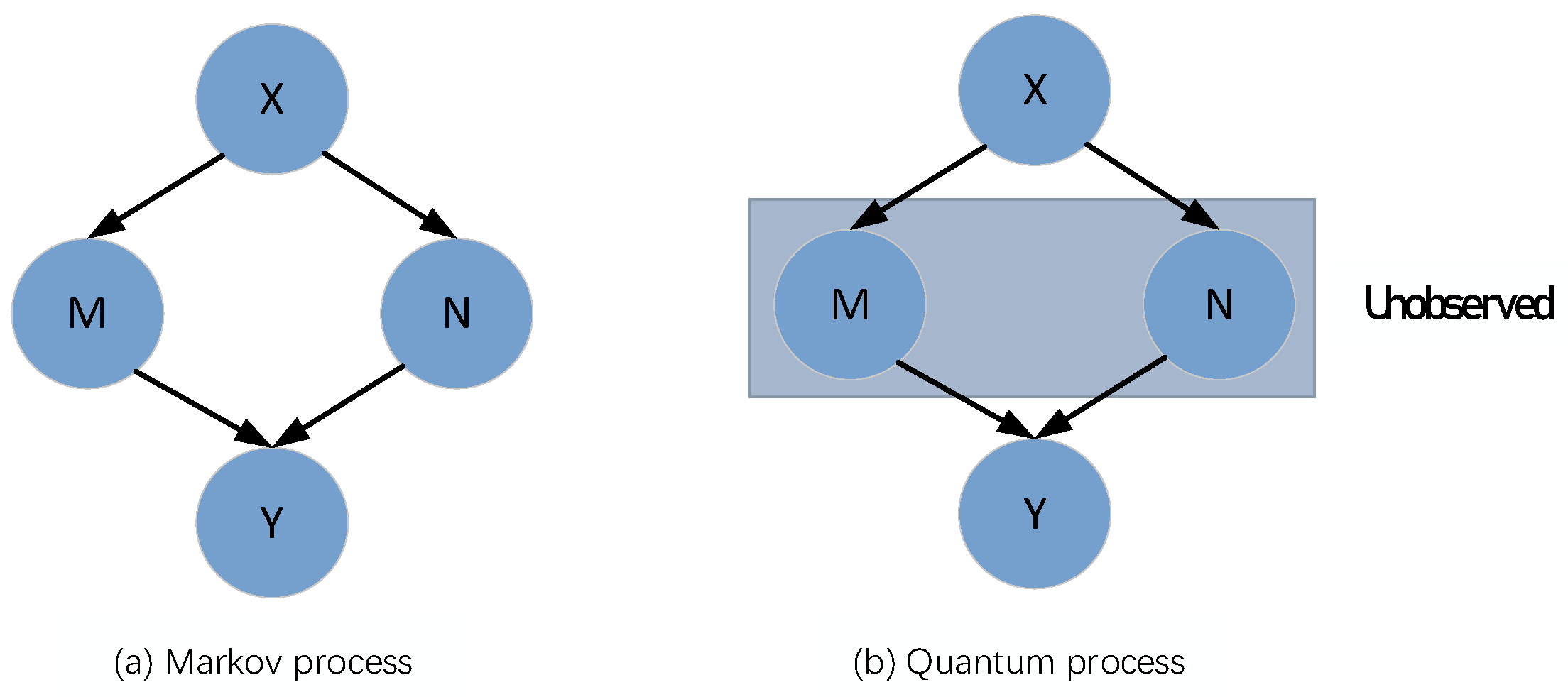
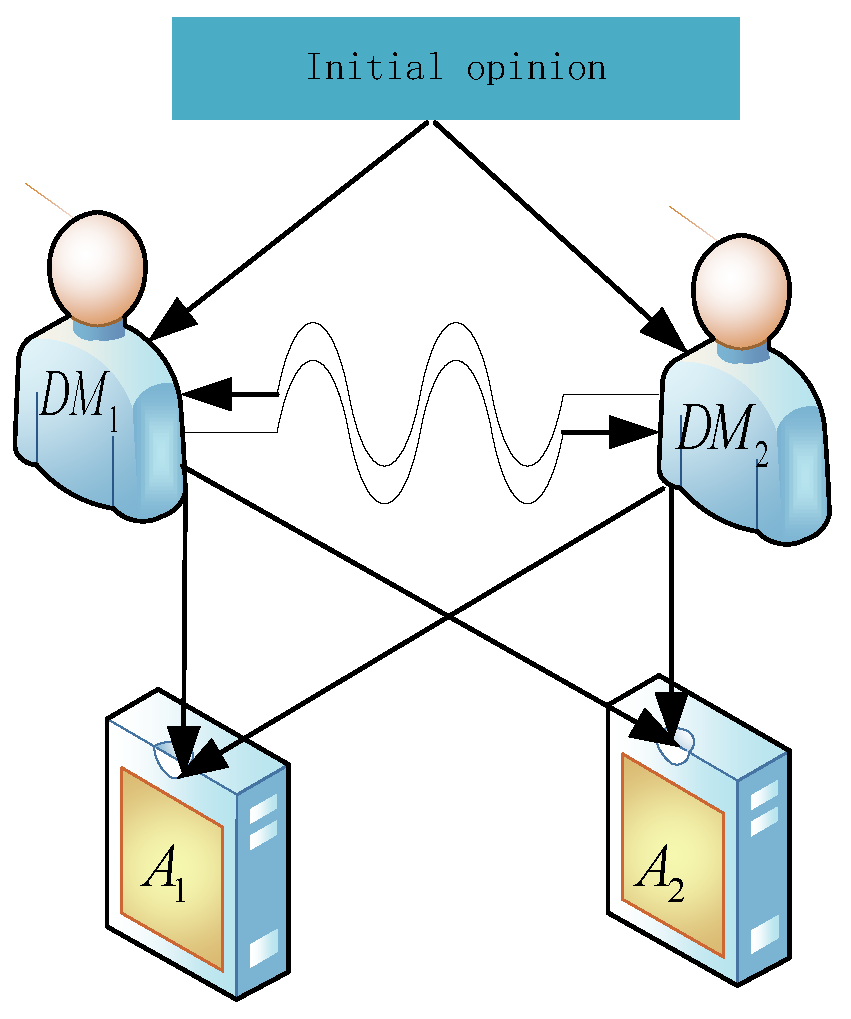
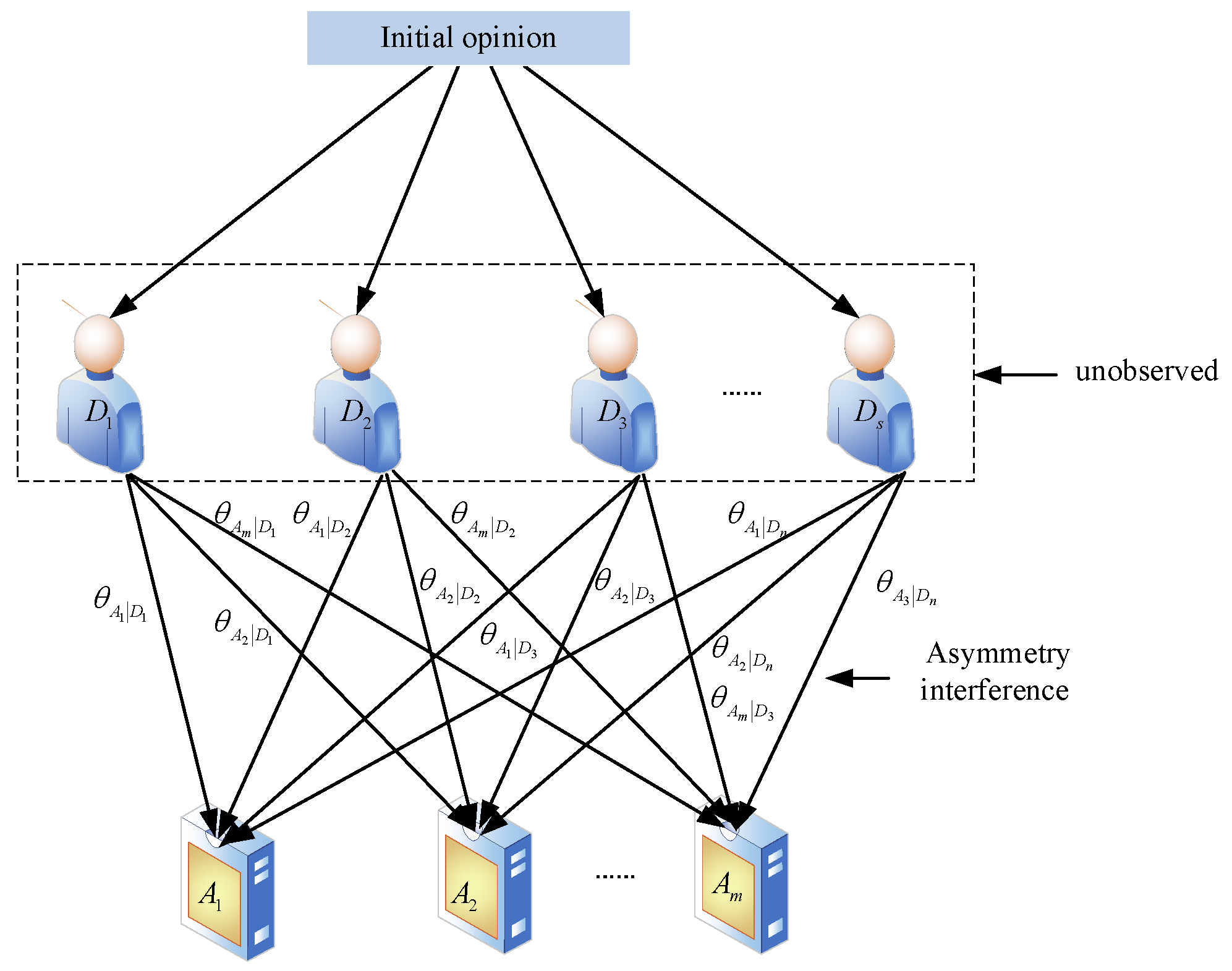

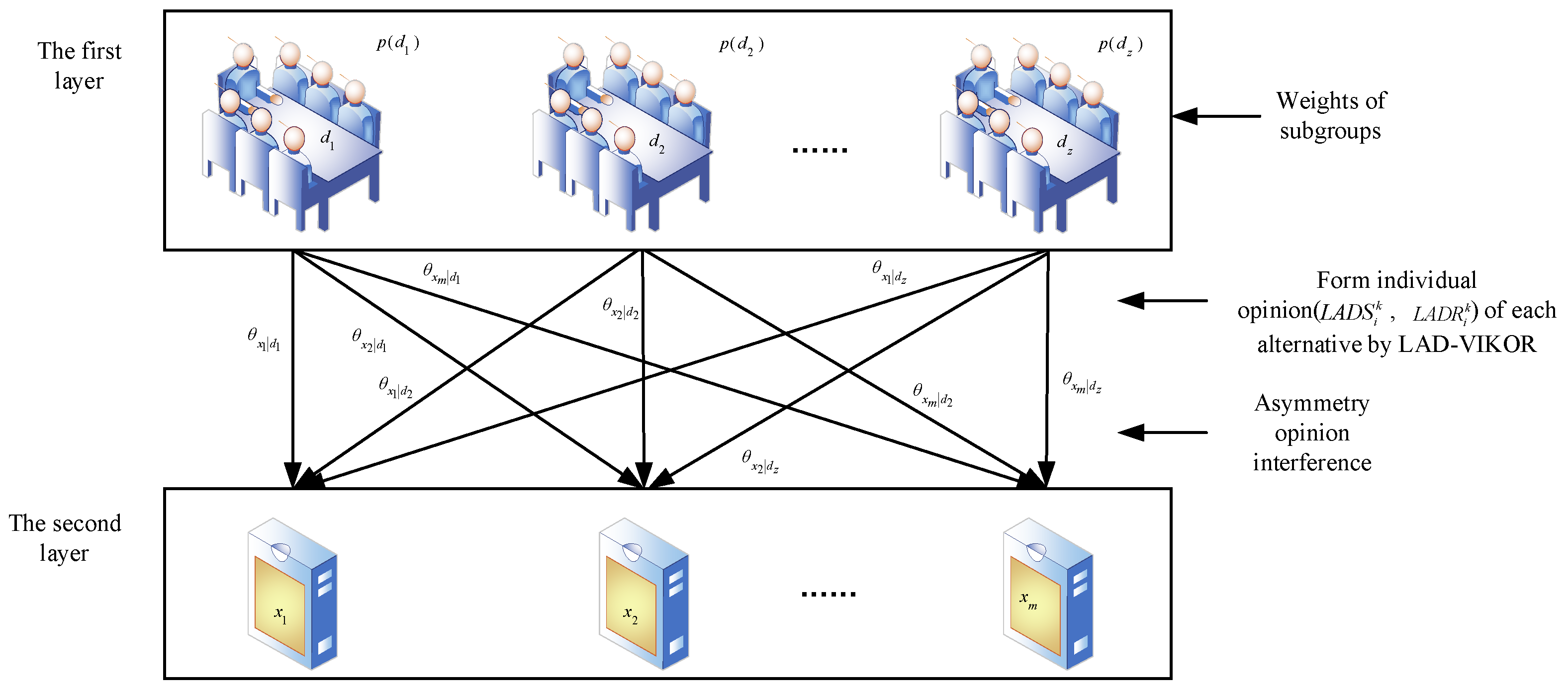
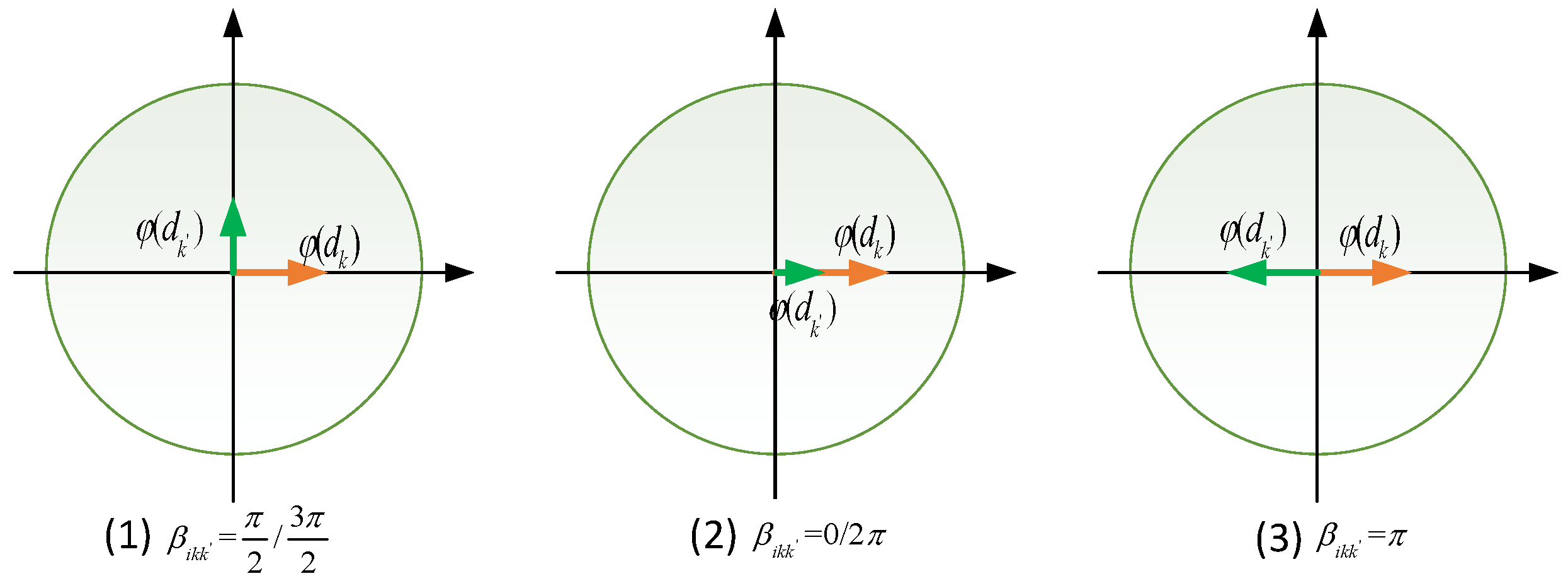
| 0.133 | 0.069 | 0.173 | |
| 0.402 | 0.236 | 0.250 | |
| 0.034 | 0.185 | 0.158 | |
| 0.430 | 0.510 | 0.419 |
| 0.060 | 0.110 | 0.245 | |
| 0.485 | 0.177 | 0.230 | |
| 0.066 | 0.305 | 0.262 | |
| 0.388 | 0.408 | 0.262 |
| 0.231 | 0.144 | 0.228 | |
| 0.401 | 0.266 | 0.274 | |
| 0.117 | 0.235 | 0.218 | |
| 0.415 | 0.391 | 0.355 |
| 0.155 | 0.182 | 0.271 | |
| 0.441 | 0.230 | 0.262 | |
| 0.163 | 0.302 | 0.281 | |
| 0.394 | 0.350 | 0.281 |
| −0.381 | −0.226 | −0.417 | |
| −0.061 | −0.161 | −0.800 | |
| −1.573 | −0.319 | −0.527 | |
| −0.495 | −0.530 | −0.197 |
| −0.482 | −1.404 | −1.295 | |
| −1.522 | −1.552 | −0.807 | |
| −0.773 | −1.231 | −0.856 | |
| −0.423 | −1.409 | −1.293 |
| Interference Terms | |||
|---|---|---|---|
| 0.782 | 0.871 | 0.762 | |
| 0.965 | 0.908 | 0.543 | |
| 0.101 | 0.818 | 0.699 | |
| 0.717 | 0.697 | 0.887 |
| Interference Terms | |||
|---|---|---|---|
| 0.725 | 0.198 | 0.260 | |
| 0.130 | 0.113 | 0.539 | |
| 0.558 | 0.297 | 0.511 | |
| 0.758 | 0.195 | 0.261 |
| Ranks of Alternatives | Compromise Solution | |||||
|---|---|---|---|---|---|---|
| 0 | 0.00 | 0.49 | 0.34 | 1.00 | ||
| 0.1 | 0.01 | 0.51 | 0.31 | 1.00 | , | |
| 0.2 | 0.02 | 0.52 | 0.27 | 1.00 | , | |
| 0.3 | 0.03 | 0.53 | 0.24 | 1.00 | , | |
| 0.4 | 0.04 | 0.54 | 0.20 | 1.00 | , | |
| 0.5 | 0.05 | 0.56 | 0.17 | 1.00 | , | |
| 0.6 | 0.06 | 0.57 | 0.14 | 1.00 | , | |
| 0.7 | 0.07 | 0.58 | 0.10 | 1.00 | , | |
| 0.8 | 0.08 | 0.59 | 0.07 | 1.00 | , | |
| 0.9 | 0.08 | 0.61 | 0.03 | 1.00 | , | |
| 1 | 0.09 | 0.62 | 0.00 | 1.00 | , |
Publisher’s Note: MDPI stays neutral with regard to jurisdictional claims in published maps and institutional affiliations. |
© 2022 by the authors. Licensee MDPI, Basel, Switzerland. This article is an open access article distributed under the terms and conditions of the Creative Commons Attribution (CC BY) license (https://creativecommons.org/licenses/by/4.0/).
Share and Cite
Xiao, J.; Cai, M.; Gao, Y. A VIKOR-Based Linguistic Multi-Attribute Group Decision-Making Model in a Quantum Decision Scenario. Mathematics 2022, 10, 2236. https://doi.org/10.3390/math10132236
Xiao J, Cai M, Gao Y. A VIKOR-Based Linguistic Multi-Attribute Group Decision-Making Model in a Quantum Decision Scenario. Mathematics. 2022; 10(13):2236. https://doi.org/10.3390/math10132236
Chicago/Turabian StyleXiao, Jingmei, Mei Cai, and Yu Gao. 2022. "A VIKOR-Based Linguistic Multi-Attribute Group Decision-Making Model in a Quantum Decision Scenario" Mathematics 10, no. 13: 2236. https://doi.org/10.3390/math10132236
APA StyleXiao, J., Cai, M., & Gao, Y. (2022). A VIKOR-Based Linguistic Multi-Attribute Group Decision-Making Model in a Quantum Decision Scenario. Mathematics, 10(13), 2236. https://doi.org/10.3390/math10132236







